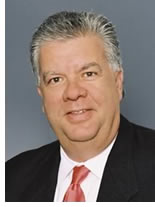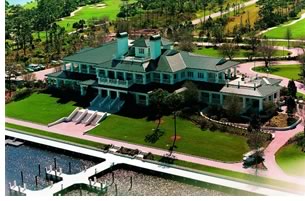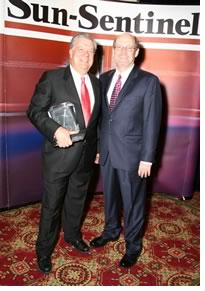

3/2006
Jorge Garcia, AIA, earns awards for both

by Tracy Ostroff
 Jorge Garcia, AIA, is a man with a mission. He balances significant
community involvement, holding numerous board positions with various
professional and charitable organizations throughout South Florida—the
Humane Society of Broward County, Boys & Girls Club, Jack & Jill
Children’s Center, Florida Atlantic University, and the Urban Land
Institute—all the while nurturing Garcia Stromberg, a nearly 20-year-old
award-winning multi-disciplinary architecture practice. For his endeavors,
the Sun-Sentinel Co. honored Garcia with the 2005 Excalibur Award, presented
to leaders in South Florida who have distinguished themselves in business
and who have made a difference in the community. With most of us vying
to simply keep our heads above water, AIArchitect speaks with Garcia
to find out how he does it all.
Jorge Garcia, AIA, is a man with a mission. He balances significant
community involvement, holding numerous board positions with various
professional and charitable organizations throughout South Florida—the
Humane Society of Broward County, Boys & Girls Club, Jack & Jill
Children’s Center, Florida Atlantic University, and the Urban Land
Institute—all the while nurturing Garcia Stromberg, a nearly 20-year-old
award-winning multi-disciplinary architecture practice. For his endeavors,
the Sun-Sentinel Co. honored Garcia with the 2005 Excalibur Award, presented
to leaders in South Florida who have distinguished themselves in business
and who have made a difference in the community. With most of us vying
to simply keep our heads above water, AIArchitect speaks with Garcia
to find out how he does it all.
What is the significance of community service and leadership?
We are involved in a profession with which I am obviously completely
enamored because it touches every aspect of life, including social,
economic, environmental, and educational issues. When you discover
how good it feels to do things that are good for somebody else—if
you do things that get away from the ego and the self-serving propositions—a
lot of other things begin to happen around it. Just by virtue of community
involvement, you meet other caring people, and caring people are also
usually very good business people and generally very successful people.
I’ve made a lot of great friends and business acquaintances,
and at the same time have exposed our organization and ourselves to
other people and entities. By virtue of being involved, you’re
surrounded by other people who are of like thinking. It has been rewarding
in that we do something good for the community and good things happen
to us.
 How do you encourage your employees to be active in community work?
How do you encourage your employees to be active in community work?
We put together a list of philanthropic and professional organizations.
We encourage everyone who has the time—and not everyone does—to
have one organization they dedicate efforts toward, including the Chamber,
the Humane Society, the Boys and Girls Club, and others. We allow them
to take time during the workday. We sponsor them when they go to these
functions and we make sure their travel and accommodations are taken
care of when they are going to do something for the community. It’s
a non-written policy. Once they get involved with it—I think
at first they think they’re going to get a little time out of
the office—all of a sudden they become impassioned by it.
What is the foundation you are working to establish?
As we have grown, one of the things we have come to terms with is that
we do something for almost every organization that comes to us. We
said, “If we’re going to participate in these things anyway,
why don’t we make a real department and issue of it?” We
have been reviewing and exploring ways, not only how we can participate
ourselves, but how we can influence those we associate with, like our
engineers, vendors, and others in our realm. We thought if we could
establish a foundation that can have and drive these fundraisers and
philanthropic functions and golf tournaments, we could bring our clients
together with our consultants and not only be a participant, but encourage
others to do so, too. We would manage it for free. It’s another
way to generate even more finances and time for these organizations
that do such a fabulous job.
 Are you ever overwhelmed by the number of requests
you receive?
Are you ever overwhelmed by the number of requests
you receive?
Yes. We’re trying to manage that. But everyone has a cause, and
there are good ones out there. It’s not a choice as far as I’m
concerned. I think it’s our obligation.
How does your commitment to community extend to your architecture practice?
It does in many ways. From a community standpoint, I’m on a couple
of governmental committees, including the planning and zoning board of
the City of Boca Raton. I thought I was just going to participate for
a little bit, but I’ve found that there’s a need for people
like myself to help shape our communities by administering the correct
land-use issues and participating in them. We also guest lecture at Florida
Atlantic University with no compensation, just to influence the level
of professionals that are being produced in our universities. We volunteer
at the Chamber of Commerce to attract good industries to our community.
All these things are a good balance of things you do for your community,
at the same time as improving the quality of life for ourselves.
 What projects characterize your practice?
What projects characterize your practice?
Architecture is so dynamic that it changes every day with societal needs.
When I’m asked if we specialize in any particular thing, I say, “Yes,
we specialize in good architecture.” The more interesting and
the more complex, the more we like it because we enjoy the challenge.
One of the interesting projects that we have done is the Floridian, a very private golf clubhouse complex in Palm City, for Wayne and Marti Huizenga [owner of the Miami Dolphins, and co-founder of Waste Management Inc. and Blockbuster, among other enterprises]. We finished it back in 1997, and to this day people who visit it come to our firm because they saw the kind of work we did there. That project was one for which we said to the client, “To achieve this level of accomplishment under this kind of schedule, you have to tell us the budget and give us full control over everything that happens inside the property lines.” This is a study in “be careful what you ask for,” because he did! Of course, he’s one of my best friends today because of the opportunity he gave us there to explore what we profess in our organization all the time, which is that we can be comprehensive and address budget and construction. In our firm, we promote the well-roundedness of the architect; that is, you need to know every aspect, from good design to good business. We also do not subscribe to the starving artist theory in architecture.
 We’re
also doing work with Blackstone right now. They are the very aggressive,
intellectually minded clients that we’ve always
wished for, and they’re not bottom-fishers in terms of fees, they
are value shoppers, as we call them. They are the perfect client because
they don’t want good design, they want great design. We’re
redoing the existing Boca Raton Hotel and its famous Beach Club. We are
also involved with other projects with them in Puerto Rico: the El San
Juan Hotel and The Conquistador, all landmarks. They rely on us to do
our jobs comprehensively.
We’re
also doing work with Blackstone right now. They are the very aggressive,
intellectually minded clients that we’ve always
wished for, and they’re not bottom-fishers in terms of fees, they
are value shoppers, as we call them. They are the perfect client because
they don’t want good design, they want great design. We’re
redoing the existing Boca Raton Hotel and its famous Beach Club. We are
also involved with other projects with them in Puerto Rico: the El San
Juan Hotel and The Conquistador, all landmarks. They rely on us to do
our jobs comprehensively.
We also have an exciting project that is really testing our skills. Its range depends on how it proceeds from between 5,000 and 12,000 acres in Nicaragua. There’s no architectural vernacular that we have to adhere to—we’re establishing everything there from ground zero. We’re getting a chance to be a part of an economy that’s going to improve by providing work for those who need it. We’re designing everything for sustainability. We’re dealing with humungous environmental issues and we’re orchestrating this whole process of doing it correctly. We’re working with the land-planning group EDSA from Ft. Lauderdale. A project of this magnitude is a moving target, because it can easily become a 10-year project and economies and markets can change. Everything we design has to be flexible. We are totally exposed there. We have to do the right thing.
How do you balance all your commitments?
I sometimes don’t know myself. I manage myself pretty well because
simultaneously I also have a wife, a daughter, and a son who plays on
a travel hockey team. The balance allows me to do it—I just have
been very strategic with my time. We have a lot more time than we think;
we just don’t manage it correctly. I don’t have any days
where I say, “Jeez, I wonder what I want to do first today.” I
know exactly what I have to do each day.
 What is your firm’s retention rate?
What is your firm’s retention rate?
Our turnover rate is very slow. Since I founded the firm in 1987, we
never lost anyone due to a lack of work or because they are dissatisfied
with the kind or work they do or how much they make. We have many people
in this organization who could go out and start their own firms, but
they choose to be part of Garcia Stromberg because we have a future
for them. They know it and live it and they get the opportunities here.
We have found the true secret to our organization has been the balance
between young, “unleashed” minds with very experienced
professionals. Somewhere in the middle we have a formula that makes
practicality out of very intellectual thinking. That keeps the older
guys enthusiastic and the younger people ambitious.
How does it feel to be publicly recognized?
I’m proud and flattered by it because it’s from colleagues
who know me or know of me and recognized me—rather than being PR-driven.
I’m also proud because it speaks to everything I’ve just
addressed. It’s not just that we’re great architects, or
great business people, or great philanthropists, or community-involvement
people, it’s because we’re all of them.
Copyright 2006 The American Institute of Architects.
All rights reserved. Home Page ![]()
![]()
Visit
the Garcia Stromberg Web site. ![]()
Images courtesy of the architect.
![]()